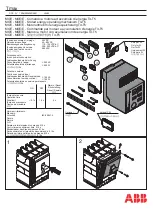
PROFIBUS Communication
3/14
WL Circuit Breaker
The following control functions are
available even without a bridge:
•
Change and set the trigger functions
for the waveform buffer
• Read the content of the waveform
buffer
• Change the setpoint parameter
• Set/change system time
• Change the free texts (comments,
system IDs)
• Reset the min./max. values
• Change the free user output on
the COM15 module
Write protection ensures that all the
required information is available at
the automation level, but prevents
any changes to the status of the
circuit breaker. Changes can only be
made by the operator of the power
distribution system.
Why does the write protection
function permit certain actions?
All actions that are not blocked are
for remote diagnosis only and do not
have any effect on the breaker status.
Trips and curves can, however, be
diagnosed more accurately, even
using remote methods.
SYNC and FREEZE
The PROFIBUS-DP features
the control commands SYNC
(synchronize outputs) and FREEZE
(freeze inputs) to enable data
exchange to be coordinated.
A DP master with the appropriate
functionality can send the SYNC
and/or FREEZE control commands
(broadcast messages) to a group
of DP slaves simultaneously. For
this purpose, the DP slaves are
arranged in SYNC and FREEZE
groups. A maximum of 8 groups
can be created for a master system.
Each DP slave, however, cannot be
assigned to more than one group.
SFC11
DPSYNC_FR
is used to trigger
the control commands from the S7
user program. Not every master
supports this function.
The SYNC control command enables
users to synchronize the outputs
on several slaves simultaneously.
When the control command SYNC
is received, the addressed DP
slaves switch the data from the
last Data_Exchange message from
the DP master in their transfer buffer
to the outputs. This enables output
data to be activated (synchronized)
simultaneously on several DP slaves.
The UNSYNC control command
cancels the SYNC mode of the
addressed DP slaves. The DP
slave then resumes cyclic data
transmission, that is, the data sent
from the DP master is immediately
switched to the outputs.
The FREEZE control command
enables the user to “freeze” the
input data of DP slaves. If a FREEZE
command is sent to a group of
DP slaves, all of these slaves
simultaneously freeze the signals
currently present at their inputs.
These can then be read by the DP
master. The input data in the DP
slaves is not updated until a new
FREEZE command has been received.
The UNFREEZE control command
cancels the FREEZE mode of the
addressed DP slaves so that they
resume cyclic data transmission
with the DP master. The input data
is immediately updated by the DP
slave and can then be read by the
DP master.
Note that once a DP slave has been
restarted or is started for the first
time, it does not switch to SYNC or
FREEZE mode until it has received
the first SYNC or FREEZE command
from the DP master.
The WL circuit breaker supports
both SYNC and FREEZE mode.
Time Synchronization
Each WL circuit breaker is equipped
with an internal clock integrated in
the COM15 PROFIBUS-DP module.
The system time cannot be buffered
during a power failure.
This internal clock must be set
accurately and synchronized with
all other devices in the system so
that if several trips occur, the source
of error can be identified. For
example, the saved messages and
the minimum/maximum values are
also assigned a time stamp and
saved. Without an accurate system
time in the COM15, events could
only be assigned time stamps by a
connected PLC with limited accuracy.
To ensure that an accurate time
stamp is provided in conjunction
with all the other circuit breakers,
the clock in each device must be
synchronized periodically with the
other circuit breakers to the correct
time. This is carried out as follows:
First import the current time from
the PLC to each circuit breaker. To
do so, send data set 68 with the
current system time to all the circuit
breakers via the acyclic DPV1 channel
services. At this point, the time does
not have to be precisely accurate
because it will be corrected during
synchronization.
WL PROFIBUS Communication and Electronic Accessories • July 2004







































